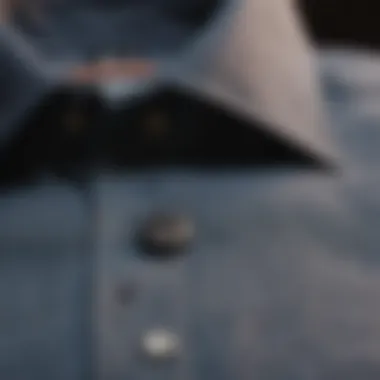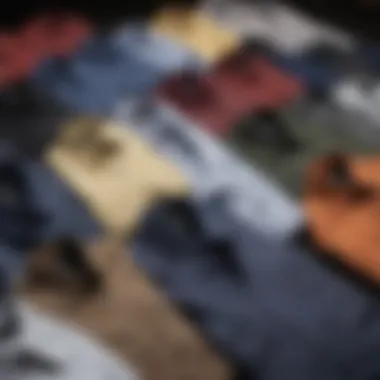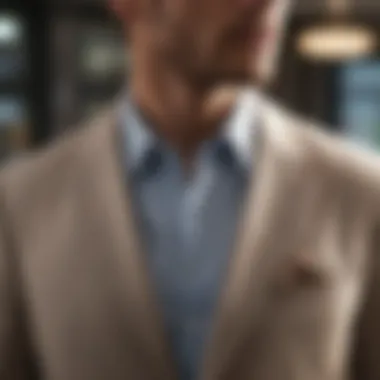The Ultimate Guide to Men's Button-Up Work Shirts


Intro
Button-up work shirts have become a staple in the professional wardrobes of men worldwide. Their combination of style, comfort, and practicality makes them a preferred choice in various workplaces. This guide aims to delve into the multiple facets of button-up work shirts. From understanding the different styles available to the importance of material choice, fit, and maintenance, this resource is designed to assist men in making informed decisions about their work attire.
In a world where first impressions often matter, the clothing you choose speaks volumes about your professionalism and personal style. The right button-up shirt can elevate one's appearance, enhance confidence, and contribute to a positive professional image. This article will provide essential insights to help navigate the vast options available.
The History of Button-Up Work Shirts
Button-up shirts have a long-standing history, tracing back to their origins in the 19th century. Initially, they served primarily functional purposes in labor-intensive jobs. As time progressed, their design evolved, morphing from rugged work garments to stylish pieces capable of making a statement in any setting.
Origin and Evolution
The button-up shirt first gained popularity among the working class, where durability and ease of wear were paramount. In the 1800s, men wore simple cotton or linen shirts, often devoid of elaborate designs. Over the decades, innovations in textile manufacturing provided greater variety in terms of fabrics and colors. By the early 20th century, button-up shirts began to permeate the business world, marking a shift toward more polished standards of dress.
Milestones and Influences
One notable milestone occurred in the 1950s when the casual dress code in the workplace began to change. The introduction of the 'smart casual' dress code allowed for more creative expression in professional attire. This period saw a rise in popularity for button-up shirts, often paired with jackets or sweaters, demonstrating versatility. The influence of pop culture also played a role. Iconic figures, from movie stars to business moguls, embraced the button-up shirt, making it synonymous with success.
Key Figures and Pioneers
Throughout history, numerous designers and fashion houses have contributed to the evolution of button-up shirts. Giovanni Battista Giorgini, for instance, is credited with showcasing American fashion on Italian runways. His influence helped popularize tailored menswear, including button-up shirts, pushing forward the notion that these shirts could embody both practicality and high style.
In contemporary society, brands like Brooks Brothers and Ralph Lauren continue to set standards for work shirts, combining traditional elements with modern aesthetics. Their innovations highlight the balance between functionality and appeal.
"The button-up shirt transitioned from a mere work garment to a powerful symbol of professionalism in the modern workplace."
As we explore the nuances of button-up work shirts, we will look into various styles, materials, fits, and other essential factors that define these garments in the professional arena.
Prelims to Button-Up Work Shirts
Button-up work shirts are more than just a part of the wardrobe. They present a blend of style, professionalism, and utility. In a professional environment, these shirts serve as a canvas for personal expression while still adhering to dress codes. Understanding the intricacies of button-up work shirts can significantly enhance one's professional image. The selections range from materials to fit and design, offering countless opportunities for customization.
Historical Context of Work Shirts
The button-up work shirt has undergone substantial transformations over the decades. Initially developed for laborers, these shirts were made from durable fabrics suited for tough environments. The early designs were primarily functional, focusing on durability and ease of movement. Gradually, with industrial advancements and cultural shifts, the button-up shirt began to incorporate fashion elements.
By the mid-20th century, the button-up work shirt found its way into corporate settings. This marked a significant shift, adding styles and patterns that appealed to professionals. Shirts also began to feature varying collar styles and materials that allowed for more versatility. The evolution resembles a timeline that charts changes in society's view of work and attire—a shift towards a more casual yet polished look.
Modern Relevance in Professional Attire
In today's working world, the button-up work shirt remains a staple in many professional wardrobes. It symbolizes a balance between formality and comfort. Many industries embrace this shirt as a central element of their dress code, from corporate offices to creative agencies. The versatility of these shirts allows professionals to express their personal style while maintainng a polished appearance.
Consider the following benefits of including button-up work shirts in a professional wardrobe:
- Versatility: Suitable for various settings, from meetings to casual Fridays.
- Style Options: Available in numerous colors, patterns, and fits to suit personal preferences.
- Comfort: Made from breathable fabrics, it provides comfort during long workdays.
The button-up work shirt is not just a piece of clothing; it's an essential component of modern professional identity. It bridges the gap between personal style and workplace expectations.
Material Variations
Understanding the different material variations in button-up work shirts is essential in making an informed choice. Fabrics influence not only the durability and comfort but also the overall aesthetic appeal of a shirt. As professionals seek to blend style with functionality, selecting the right material can enhance performance while maintaining a polished look. The importance of material variations lies in their attributes such as breathability, ease of care, and their ability to contribute to a workplace's dress code requirements.
Cotton: The Staple Material


Cotton is arguably the most common fabric for work shirts. Known for its softness and breathability, cotton effectively absorbs sweat and allows air circulation, making it a comfortable option for long work hours. It is also versatile, fitting well into both corporate and casual settings. Cotton shirts are easy to care for and typically can withstand numerous washes without losing their shape or color. However, one drawback is that 100% cotton can wrinkle easily, which may require more maintenance.
Polyester and Blends
Polyester is recognized for its durability and moisture-wicking properties. When blended with cotton, it creates a fabric that retains the softness of cotton while enhancing the shirt's resilience against wrinkles and fading. Polyester blends are excellent for work environments that demand both style and practicality. These fibers dry quickly and require less ironing, making them lower maintenance upon care. Perfect for those who prioritize convenience, these shirts can perform well in various professional settings without sacrificing looks.
Performance Fabrics for Active Work Environments
For individuals in physically demanding jobs, performance fabrics come into play. These materials are designed to offer maximum flexibility, breathability, and moisture management. Polyester stands out in this category, especially when engineered with additional features like UV protection and anti-odor technology. Fabrics such as spandex or specialized blends allow for extended mobility, making them ideal for sectors such as construction or logistics. Performance fabrics ensure that even in intense work situations, the wearer's comfort and professional appearance are not compromised.
Key Consideration: When selecting a work shirt material, consider the specific work environment and activities involved. Your shirt should not only represent your professional image but also support your performance and comfort throughout the day.
Design Considerations
Design considerations for button-up work shirts are essential for professionals who want to balance functionality and style. Each element of design contributes to the overall appearance, comfort, and practicality of the shirt. When choosing a work shirt, it is not only the look that matters but also how these design elements serve specific needs in various professional settings.
Collar Styles: Selection and Impact
The collar is one of the most defining features of a button-up work shirt. Different styles such as the spread collar, point collar, and button-down collar can significantly affect the overall look and function.
- Spread Collar: This collar adds a modern touch. It is appropriate for most corporate environments and allows space for a tie.
- Point Collar: This is more traditional and versatile. It suits both formal and semi-formal settings.
- Button-Down Collar: This style is practical, keeping the collar in place, ideal for hands-on work environments.
Choosing the right collar style impacts how the shirt presents itself and how the wearer feels. A well-chosen collar can project authority and professionalism, crucial in a business setting.
Pocket Placement and Functionality
Pocket placement is another critical consideration in the design of work shirts. The position and function of pockets can vary widely.
- Chest Pockets: Positioned either on the left, right, or both sides, these pockets are useful for storing pens, notepads, or small tools.
- Hidden Pockets: Some shirts feature hidden pockets within the seam for a sleek look while maintaining functionality.
Understanding how pockets function in daily tasks can guide one’s choice. Functional pockets can enhance convenience without sacrificing aesthetics.
Sleeve Length and Types
Sleeve length and type are integral to the comfort and adaptability of a work shirt. Short sleeves, long sleeves, and even three-quarter sleeves offer different benefits.
- Long Sleeves: Ideal for cooler environments, providing warmth and layer options.
- Short Sleeves: Allow for ventilation, fitting well in warmer settings while maintaining a business-ready appearance.
- Roll-Up Sleeves: This feature offers versatility, allowing for a change in style according to activity or temperature.
Selecting the right sleeve length and type ensures that the work shirt provides comfort throughout the day, adapting to different professional demands.
The design elements of a button-up work shirt not only reflect personal style but also serve essential roles in professional environments.
Fit and Comfort
When selecting a button-up work shirt, fit and comfort are paramount. They influence not only the wearer's comfort throughout the day but also their overall professional appearance. A well-fitted shirt communicates care and attention to detail, which can significantly affect one's confidence and effectiveness on the job.
Tailored vs.
Loose Fit Options
Understanding the distinction between tailored and loose fit options is essential when choosing a work shirt.
- Tailored Fit: This type is designed to contour to the body’s shape, providing a streamlined look. It often flatters the wearer, making it suitable for more formal corporate environments. The tailored fit can enhance a professional appearance and project a sense of authority.
- Loose Fit: This design offers more room through the body and sleeves. It is preferable for roles that require substantial movement or physical activity. While it may lack the structured aesthetic of a tailored shirt, it allows for breathability and comfort in various working conditions.


Choosing the right fit depends on the nature of the job and personal style preferences. Considering how each option influences mobility and perception can help in making an informed choice.
Impact of Fit on Professional Appearance
The fit of a work shirt does more than influence comfort; it directly impacts professional appearance. A shirt that fits well enhances the silhouette of the wearer, conveying confidence and professionalism. In contrast, an ill-fitting shirt can detract from an otherwise polished look.
Employers and clients often make initial assessments based on non-verbal cues, including attire. Therefore, ensuring that a shirt aligns well with one’s body type can be advantageous in creating a positive impression. A tailored fit denotes attention to detail and respect for the work environment, while a loose fit may project approachability but can sometimes be perceived as less professional if not styled correctly.
Movement and Flexibility Needs
Work environments vary greatly, and so do the demands they put on an individual's clothing. The degree of movement and flexibility required can greatly influence the choice of a work shirt.
In roles that involve extensive physical activity, such as in construction or warehousing, a loose-fitting shirt may provide the necessary freedom of movement. Conversely, a job in finance or consulting may demand a more structured shirt that maintains a polished look but still allows moderate movement.
Consider the specific tasks involved in your role when selecting a shirt. Look for features like:
- Stretch fabric: This can offer more flexibility without sacrificing style.
- Ventilation: Shirts with strategic ventilation can enhance comfort in physically demanding situations.
In summary, evaluating the dynamic requirements of your profession will help determine the appropriate fit that maintains both comfort and a professional appearance.
Color and Pattern Choices
Choosing appropriate colors and patterns for button-up work shirts is vital for establishing a professional image. This section explores the nuances of selecting colors and patterns that not only appeal aesthetically but also convey the right message in various work environments. One must consider factors such as industry standards, personal branding, and even the psychological impact of colors. Understanding these elements can transform a simple shirt into a powerful tool for self-expression while maintaining professionalism.
Classic Colors for a Professional Look
Classic colors like white, light blue, and navy have long been staples in professional wardrobes. Each of these colors serves its purpose and has its own strengths. For instance:
- White: Represents cleanliness and simplicity. It is versatile and pairs well with almost any pants or accessories. A well-fitted white shirt can project confidence and authority.
- Light Blue: Offers a soft, approachable alternative to stark white. It evokes a sense of calm and trust, which is why it is popular in client-facing roles.
- Navy: A deeper color that stands for stability and professionalism. It can easily transition from day to night, making it suitable for formal meetings and casual after-hours gatherings.
Key Point: Wearing classic colors can significantly elevate your professional presence without drawing undue attention.
Utilizing Patterns to Showcase Personality
Patterns can be a powerful means of self-expression. Subtle patterns like pinstripes or checks can add depth to a classic shirt while maintaining a professional look. However, when selecting patterns, some considerations must be taken into account:
- Business Environment: Consider the culture of your workplace. A creative industry might embrace bolder patterns, while a corporate environment may require more muted options.
- Subtlety over Flashiness: Opt for patterns that enhance rather than overwhelm. A delicate checkered pattern can add interest without distracting from your overall look.
- Mixing Patterns: If you choose to layer patterns, ensure that there is a common color that ties everything together. This maintains cohesiveness without appearing chaotic.
Seasonal Color Trends in Work Shirts
Staying updated on seasonal color trends is essential for modern professionals. Colors can evoke emotions or set a seasonal mood. For example:
- Spring/Summer: Lighter colors, like pastels, reflect the freshness of the season. Soft greens and light yellows can bring a sense of renewal while remaining professional.
- Autumn/Winter: Richer shades such as maroon, deep green, and earth tones can work well. These colors typically convey warmth and approachability during the colder months.
Incorporating seasonal colors not only helps you remain fashionable but can also demonstrate your awareness of trends, showing colleagues and superiors that you are engaged and professional in your appearance.
By understanding and implementing thoughtful choices in color and pattern selections, professionals can enhance their wardrobe while staying true to their personal style. It requires balance, but the result is a polished look that reflects both competency and individuality.
Choosing the Right Work Shirt for Different Professions
Selecting the appropriate button-up work shirt is crucial for men in various professions. This choice not only conveys a sense of professionalism but also adapts to the unique demands of different careers. Understanding how work shirts fit various environments can elevate one's appearance and ensure comfort throughout the workday.
Corporate Environments


In corporate settings, the work shirt serves as a significant element of a professional wardrobe. Here, crisp appearance and attention to detail are essential. Opting for tailored shirts in solid colors or subtle patterns is advisable, as they project competence and seriousness. Shirt fabrics like cotton or cotton-polyester blends offer breathability while maintaining a polished look.
Consider pairing these shirts with tailored suits or dress pants. Classic colors like white, light blue, or soft grey provide an excellent base. Furthermore, ensuring a proper fit is critical; overly tight or baggy shirts may lead to discomfort or an unprofessional image.
Creative Fields
In creative professions, there is more freedom in choosing work shirts. Here, it's essential to reflect personal style while still maintaining a degree of professionalism. Patterns and colors can be more diverse, allowing for expression without crossing the line into casual wear.
Shirts with unique designs or vibrant colors can enhance creativity in the workplace. Fabrics like lightweight cotton or sustainable blends are often preferred for comfort and style. It's important to balance creativity with professionalism, so consider the company culture when making your selection.
Hands-On Jobs
For hands-on jobs, including trades and fieldwork, functionality is paramount. The work shirt should offer flexibility and durability. Fabrics that resist wear and tear, like canvas or thicker cotton blends, are preferable. Features like reinforced seams, pockets, and appropriate sleeve lengths enhance practicality.
Choosing a shirt with a looser fit allows for movement, which is essential in physically demanding roles. Colors may vary, but darker shades could be practical as they may hide stains better than lighter colors. It's advisable to prioritize comfort and utility over style in this context, keeping in mind that practicality often leads to increased efficiency in the workplace.
Overall, understanding the requirements of each profession is vital when choosing the right work shirt. Comfort, fit, and style must align with the specific demands of the role.
Care and Maintenance
Caring for button-up work shirts is crucial to preserve their appearance and longevity. Regular maintenance not only enhances the aesthetics but also ensures the functionality of the garment. A well-maintained shirt can project professionalism and attention to detail in any environment.
Washing and Drying Guidelines
When it comes to washing button-up work shirts, following specific guidelines helps to maintain their look. Always check the care label for instructions. Generally, it is advisable to:
- Wash with cold water to prevent shrinking and fading
- Use a gentle cycle, especially for shirts made of delicate fabrics
- Avoid bleach, which can damage the fabric over time
- Instead, opt for mild detergents
For drying, air drying is preferred. If a dryer is used, select a low heat setting to minimize damage. This approach not only aids in maintaining the integrity of the fabric but also conserves energy.
Ironing and Storage Techniques
Ironing button-up work shirts can be essential to achieve a crisp look. Follow these steps:
- Start with the collar, pressing from the points to the center
- Move to the sleeves, ensuring to press both sides
- Finally, iron the body, working from the top down
Using a steam iron can help eliminate wrinkles effectively. When storing shirts, hang them in a cool, dry place. Avoid overcrowding in the closet to minimize creasing. If stacking, ensure they are folded neatly, with each shirt laid flat.
Recognizing Signs of Wear
Being aware of signs of wear is vital for maintaining a polished appearance. Inspect shirts regularly for:
- Faded colors or fabric thinning
- Missing buttons or stitching issues
- Persistent stains that do not wash out
Addressing these issues promptly can prolong the lifespan of your work shirts. Repairing small damages is often more cost-effective than replacing the entire garment. Keeping shirts in top condition reflects not only personal pride but also professional standards.
Regular care can extend the life of your work shirts and enhance your overall appearance.
Ending
In summary, the exploration of button-up work shirts for men is crucial not only for understanding their historical and contemporary significance, but also for navigating the nuanced aspects of selection and maintenance. This article has highlighted how appropriate work attire influences professional appearance and personal style. By focusing on key elements such as material, fit, and design, individuals are equipped to make informed decisions that enhance both comfort and professionalism in diverse work environments.
Recap of Key Points
- Historical Context: Work shirts have evolved from functional garments to essential items in professional settings.
- Material Variations: Understanding the differences between cotton, polyester, and performance fabrics is vital for durability and comfort.
- Design Considerations: Features like collar styles, pocket placement, and sleeve types can greatly affect the overall impression of the shirt.
- Fit and Comfort: Different fits not only provide varied looks but also impact how the wearer feels during long hours of work.
- Color and Pattern Choices: Selecting colors and patterns that align with corporate imagery or personal style enhances professional attire.
- Care and Maintenance: Proper handling ensures items remain in excellent condition, extending their life.
Final Thoughts on Style and Functionality
Ultimately, button-up work shirts embody the balance between style and functionality. For professionals, these shirts are not just about aesthetics but are also a reflection of their work ethic and commitment. A well-chosen shirt manages to communicate competency while allowing for personal expression. When selecting a work shirt, it is beneficial to think about the specific requirements of the job, as well as how it aligns with one's personal style. Finding this balance creates a wardrobe that is not only practical but also conducive to professional success.







